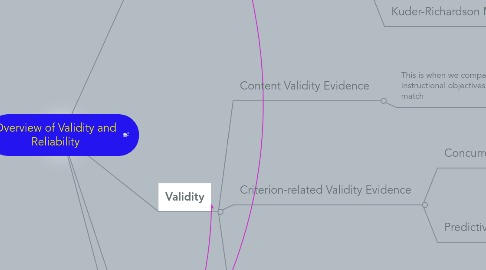
1. Reliability
1.1. Test-Restest
1.1.1. This is when the same test is given twice to the same group of people, with a small amount of time in between tests and then a correlation between the two test scores is determined
1.1.1.1. The importance of this is that if there is a high correlation between the scores from each test, then we can conclude that the test is fairly reliable.
1.2. Alternate Forms or Equivalence
1.2.1. This is when two tests are given to the same group of people with the tests being equivalent forms
1.2.1.1. This is important because if student scores vary widely between tests that are designed to measure the same thing, then we can conclude that they are not reliable in assessing what they are meant to assess
1.3. Internal Consistency
1.3.1. Split-Half Methods
1.3.1.1. This is when a test is split into 2 equal halves to determine the correlation and thus, the reliablity
1.3.1.1.1. This is important and useful because it only requires one test. With the one test we can determine how reliable the test is and thus, whether or not it will help us assess student achievement and learning
1.3.2. Kuder-Richardson Methods
1.3.2.1. This helps determine how much a test represents a single, and decently consistent measure of a concept
1.3.2.1.1. This is important for assessment and learning because it also helps determine how representative of an objective the items on a test are. Therefore, helping to determine how reliable the test is to use for determining achievement among students.
2. Validity
2.1. Content Validity Evidence
2.1.1. This is when we compare a test item with instructional objectives to see if they match
2.1.1.1. This type of validity is important because it helps teachers know if they are testing students on information that pertains to the instructional objectives
2.2. Criterion-related Validity Evidence
2.2.1. Concurrent validity evidence
2.2.1.1. Correlating test scores with a criterion measure collected at the same time
2.2.1.1.1. This type of validity is important because it helps us know - through correlation - if a new test is likely to be successful. If it is, then we have a potential test to help measure achievement of students
2.2.2. Predictive validity evidence
2.2.2.1. Correlating test scores with a criterion measure collected in the future - after a period of time
2.2.2.1.1. This type of validity is important because it helps us determine if students will be successful in some future situation. For example, the scores on the SAT help colleges estimate if students will be successful at their school.
2.3. Construct Validity Evidence
2.3.1. Figuring out whether test results correspond with scores on other variables as predicted by some rationale or theory
2.3.1.1. This helps us get a better idea of the accuracy of a theory pertaining to a certain situation. If this test correlates to what we thought would happen, then it indicates that our theory is valid.
